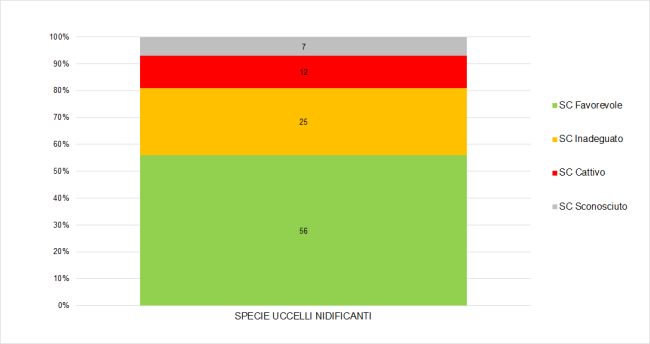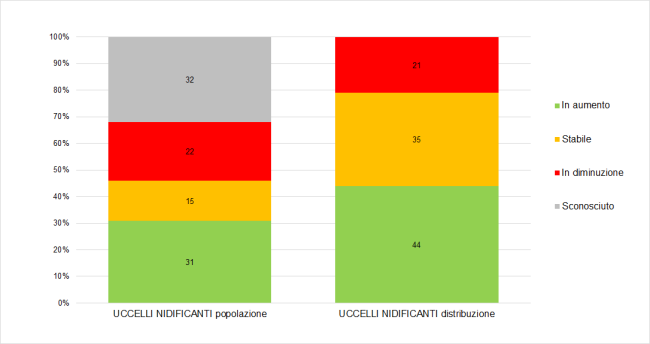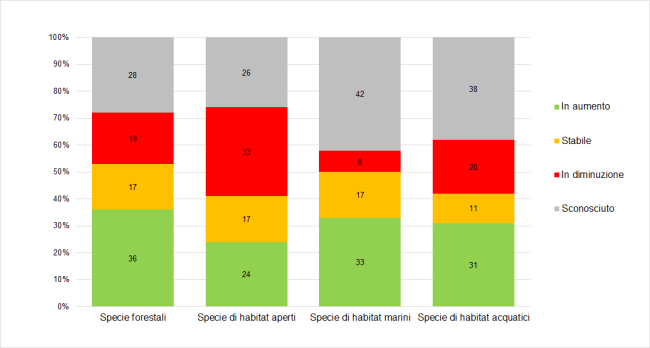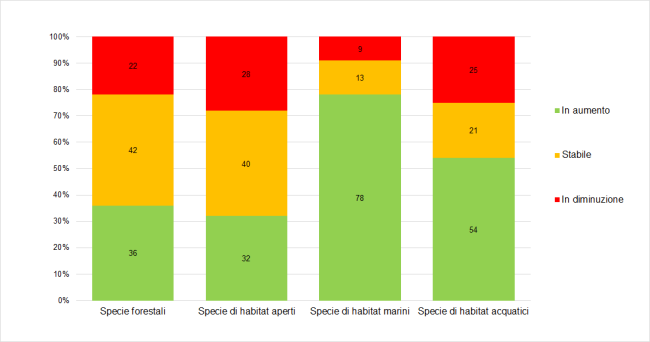Panel 1
Daniele Baroni, Simona Imperio, Riccardo Nardelli, Lorenzo Serra
This indicator provides a national overview of the conservation status of 268 breeding bird species assessed in the reporting under Article 12 of the Birds Directive 2009/147/EC. The assessment includes species of community interest listed in Annexes I and II of the Directive, as well as those that justify the designation of Special Protection Areas (SPAs).
At the national level, the percentage of species with a favourable conservation status increased from 51% (reporting period 2007-2012) to 56% (reporting period 2013-2018). However, this increase was insufficient to meet the target set by the EU Biodiversity Strategy 2020 (76%).
The short-term population trends, which reflect processes occurring in the last decade, indicate that 46% of species are increasing or stable, while nearly 25% of species are in decline (the population trend of the other 33% remains unknown). Regarding short-term trends in distribution range, the proportion of declining species is lower, as only the most severe declines result in range contractions: 21% of species show a contraction, while the remaining 79% have stable or expanding ranges.
The indicator is based on the conservation status of breeding bird species in Italy as reported under Article 12 of the Birds Directive 2009/147/EC. Specifically, it refers to the reporting period 2013-2018, covering 268 breeding bird species, including all native and naturalised species regularly breeding in Italy. These include species of community interest listed in Annexes I and II of the Directive, as well as the other species triggering the designation of Special Protection Areas (SPAs).
The conservation status is assessed using IUCN criteria, based on absolute population size, distribution range, and trends compared to the previous reporting period (2007-2012). Trends are categorized as increasing, stable, decreasing, or unknown. Additionally, the analysis of population and range trends at both national and ecological guild levels helps to assess the effectiveness of conservation policies across different ecological contexts.
To assess the conservation status of breeding birds in Italy, expressed as the proportion of species with a favourable conservation status relative to the total number of species reported under the Birds Directive. The indicator provides a summary of the Directive's implementation status, tracking progress and identifying current gaps in data collection and conservation strategies.
The Birds Directive (2009/147/EC) was the first legal instrument adopted by the European Union for biodiversity conservation and enabled the harmonization of bird protection laws across EU member states. The Directive also establishes requirements for national reports on its implementation (Article 12).
In 2019, Member States submitted their second report under Article 12 of the Birds Directive, using a reporting format established in 2011 and updated in 2016. These reports are mandatory for all regularly occurring breeding species, as well as for wintering and migratory populations listed in Annex I or those not listed in Annex I but contributing to SPA designations.
The roles and responsibilities of different institutional bodies involved in the reporting process are defined by the Interministerial Decree of November 6, 2012, which assigns ISPRA (on behalf of the Ministry of Environment) the task of collecting and analysing data provided by regions and autonomous provinces. During the national integration of regional and provincial data, ISPRA reviews the information based on the latest scientific knowledge, often collaborating with national and regional experts.
The reference target for the indicator in the 2013-2018 reporting period was set by the EU Biodiversity Strategy 2020, which aimed to increase by 50% the proportion of species with a favourable conservation status among those evaluated under the Directive. This target was to be achieved by 2020.
Panel 2
EEA, 2020: State of nature in the EU. Results from reporting under the nature directives 2013–2018, Technical report No 10/2020, European Environment Agency, Copenhagen.
ISPRA - Ercole S., Angelini P., Carnevali L., Casella L., Giacanelli V., Grignetti A., La Mesa G., Nardelli R., Serra L., Stoch F., Tunesi L., Genovesi P. (ed.), 2021. Rapporti Direttive Natura (2013-2018). Sintesi dello stato di conservazione delle specie e degli habitat di interesse comunitario e delle azioni di contrasto alle specie esotiche di rilevanza unionale in Italia. Serie Rapporti 349/2021.
https://www.isprambiente.gov.it/files2021/pubblicazioni/rapporti/rapporto-349_2021_direttive_natura_def.pdf
ISPRA - Nardelli R., Andreotti A., Bianchi E., Brambilla M., Brecciaroli B., Celada C., Dupré E., Gustin M., Longoni V., Pirrello S., Spina F., Volponi S., Serra L., 2015. Rapporto sull’applicazione della Direttiva 147/2009/CE in Italia: dimensione, distribuzione e trend delle popolazioni di uccelli (2008- 2012). Serie Rapporti, 219/2015.
Gustin, M., Nardelli, R., Brichetti, P., Battistoni, A., Rondinini, C.,Teofili, C. (compilatori), 2021. Lista Rossa IUCN degli uccelli nidificanti in Italia 2021. Comitato Italiano IUCN e Ministero dell’Ambiente e della Tutela del Territorio e del Mare, Roma.
Röschel, L., Noebel, R., Stein, U., Naumann, S., Romão, C., Tryfon, E., Gaudillat, Z., Roscher, S., Moser, D., Ellmauer, T., Löhnertz, M., Halada, L., Staneva, A., Rutherford, C., 2020. State of Nature in the EU - Methodological paper. Methodologies under the Nature Directives reporting 2013-2018 and analysis for the State of Nature 2000. ETC/BD report to the EEA. (https://www.eionet.europa.eu/etcs/etc-bd/products/etc-bd-reports/etc-bd-technical-paper-2-2020-state-of-nature-in-the-eu-methodological-paper-methodologies-under-the-nature-directives-reporting-2013-2018-and-analysis-for-the-state-of-nature-2000)
Storchová, L., Hořák, D., 2018. Life‐history characteristics of European birds. Global ecology and biogeography, 27(4), 400-406.
Knowledge gaps persist across different regions and autonomous provinces in Italy, due to the lack of long-term monitoring plans and the reliance on expert-based assessments.
Systematic initiation of national monitoring plans (at the level of individual species or groups with similar ecology). At present, data collection is sufficiently uniform in the transmission phase from regions and autonomous provinces to ISPRA, but requires stricter harmonisation to ensure national consistency.
Data quality assessment
ISPRA (Institute for Environmental Protection and Research)
MASE (Ministry of the Environment and Energy Security)
Data and documents available for download from the Central Data Repository of the European Environment Agency (EEA).
Reporting cycle results for the period 2013-2018 available in the ISPRA volume, Report Series 349/2021.
National
2013-2018
Indicator assessment
The conservation status of each breeding species was determined based on the methodological guidelines outlined by Röschel et al. (2020) for the State of Nature in the EU (EEA, 2020). Species were classified according to IUCN criteria based on absolute population size, distribution range, and short-term trends. Species in the IUCN threat categories (“Vulnerable,” “Endangered,” “Critically Endangered,” or “Extinct”) were classified as having a poor conservation status, while those in the “Near Threatened” category were classified as having an unfavourable conservation status. All other species were classified as having a favourable status or, if data are lacking, as unknown.
Short-term trends were evaluated over a period as close as possible to the last two reporting periods (2007-2018), with some deviations due to data availability. Population trends were classified as increasing, stable, decreasing, or unknown, while range trends were classified as increasing, stable, or contracting.
Italy’s national adaptation of the EU Biodiversity Strategy 2020 aimed to increase the proportion of species with a favourable conservation status from 51% (2007-2012) to 76% by 2020. However, this target was not met, as the final 2013-2018 figure remained at 56%, only slightly higher than in the previous cycle and still below the goal.
Although the percentage of species with a favourable conservation status increased from 51% (2007-2012) to 56% (2013-2018), the overall trend is considered stable because this improvement is too modest compared to the targets set by the Biodiversity Strategy.
Data
Figure 4: Percentage frequency of categories defining short-term change trends in range extent, differentiated by ecological guild* (2013-2018)
ISPRA
* species related to forest habitats, open habitats, marine environment and aquatic habitats of inland areas




The indicator summarizes the results of the Italian report under Article 12 of the Birds Directive for the period 2013–2018, specifically regarding the monitoring of 268 breeding bird populations. The short-term population trends reflect the processes underway over the last decade: 46% of the species show either population growth or demographic stability, but nearly a quarter of the species are in decline (the remaining 32% have an unknown population trend). Regarding the trends in the extent of distribution ranges, the frequency of species in decline is lower than that observed in population trends, as only the most pronounced population declines also lead to range contractions: 21% of species show a reduction in range, while the remaining 79% display a stable or expanding breeding range in terms of extent.
Among Annex I species, populations with positive short-term trends account for the largest percentage. However, at least 15 populations have undergone demographic decline, including species of extremely high conservation interest, such as the Lanner Falcon Falco biarmicus, the Rock Ptarmigan Lagopus muta, and the Barred Warbler Sylvia nisoria.
Regarding the national conservation status, as shown in Figure 1, 37% of species have been categorized as threatened or near threatened, while 56% enjoy a favorable conservation status. Critically endangered species include the Reed Bunting Emberiza schoeniclus, the Barred Warbler Sylvia nisoria (with marked short-term declines), the Bearded Vulture Gypaetus barbatus (with a growing population but still very limited and localized distribution), the Spotted Crake Porzana porzana, the Egyptian Vulture Neophron percnopterus, the Little Crake Zapornia parva, the Sedge Warbler Acrocephalus schoenobaenus, and the Black Tern Chlidonias niger (with stable or unknown trends). It is worth noting that 11 of the 30 most endangered species are not included in Annex I, and 8 of them belong to the order Passeriformes.
For some breeding species (such as the Moustached Warbler Acrocephalus melanopogon, the Lesser Grey Shrike Lanius minor, the Calandra Lark Melanocorypha calandra, and the Barred Warbler Sylvia nisoria), the population decline appears to be corroborated by a significant reduction in range—a phenomenon that has also clearly affected the Short-toed Lark Calandrella brachydactyla, the Ortolan Bunting Emberiza hortulana, the Rock Partridge Alectoris graeca, the Little Tern Sternula albifrons, and the Spotted Crake Porzana porzana.
Across the breeding bird fauna as a whole, negative population trends (a total of 59) are present in the majority of avian orders, with the Passeriformes order accounting for 74% of all declining populations.
The classification of breeding birds into ecological guilds (sensu Storchová and Hořák, 2018) reveals further specificities in both population trends (Figure 3) and changes in distribution coverage (Figure 4). In particular, species associated with open habitats are the most threatened, showing by far the highest percentage of species in decline in terms of both population size and distribution. In contrast, forest species show the highest percentage of increasing populations and expanding ranges. However, within this latter ecological guild, there remains a significant number of declining species that warrant attention. Species linked to aquatic and marine habitats show a lower frequency of declining species but, notably, also the highest number of species with unknown population trends, underscoring the importance of enhancing monitoring efforts for these species.